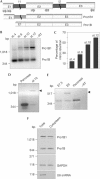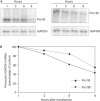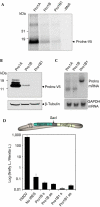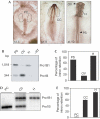Developmental regulation of a proinsulin messenger RNA generated by intron retention
- PMID: 16179943
- PMCID: PMC1369204
- DOI: 10.1038/sj.embor.7400539
Developmental regulation of a proinsulin messenger RNA generated by intron retention
Abstract
Proinsulin gene expression regulation and function during early embryonic development differ remarkably from those found in postnatal organisms. The embryonic proinsulin protein content decreased from gastrulation to neurulation in contrast with the overall proinsulin messenger RNA increase. This is due to increasing levels of a proinsulin mRNA variant generated by intron 1 retention in the 5' untranslated region. Inclusion of intron 1 inhibited proinsulin translation almost completely without affecting nuclear export or cytoplasmic decay. The novel proinsulin mRNA isoform expression was developmentally regulated and tissue specific. The proportion of intron retention increased from gastrulation to organogenesis, was highest in the heart tube and presomitic region, and could not be detected in the pancreas. Notably, proinsulin addition induced cardiac marker gene expression in the early embryonic stages when the translationally active transcript was expressed. We propose that regulated unproductive splicing and translation is a mechanism that regulates proinsulin expression in accordance with specific requirements in developing vertebrates.
Figures






Similar articles
-
Developmentally regulated expression of the preproinsulin gene in the chicken embryo during gastrulation and neurulation.Endocrinology. 1994 Dec;135(6):2342-50. doi: 10.1210/endo.135.6.7988416. Endocrinology. 1994. PMID: 7988416
-
Alternative splicing variants of proinsulin mRNA and the effects of excess proinsulin on cardiac morphogenesis.FEBS Lett. 2013 Jul 11;587(14):2272-7. doi: 10.1016/j.febslet.2013.05.060. Epub 2013 Jun 6. FEBS Lett. 2013. PMID: 23747309
-
Optimal antisense target reducing INS intron 1 retention is adjacent to a parallel G quadruplex.Nucleic Acids Res. 2014 Jul;42(12):8161-73. doi: 10.1093/nar/gku507. Epub 2014 Jun 17. Nucleic Acids Res. 2014. PMID: 24944197 Free PMC article.
-
(Pro)insulin and insulin-like growth factor I complementary expression and roles in early development.Comp Biochem Physiol B Biochem Mol Biol. 1998 Sep;121(1):13-7. doi: 10.1016/s0305-0491(98)10105-0. Comp Biochem Physiol B Biochem Mol Biol. 1998. PMID: 9972280 Review.
-
Proinsulin in development: New roles for an ancient prohormone.Diabetologia. 2006 Jun;49(6):1142-50. doi: 10.1007/s00125-006-0232-5. Epub 2006 Apr 5. Diabetologia. 2006. PMID: 16596360 Review.
Cited by
-
Comparative cross-species alternative splicing in plants.Plant Physiol. 2007 Jul;144(3):1632-41. doi: 10.1104/pp.107.098640. Epub 2007 May 11. Plant Physiol. 2007. PMID: 17496110 Free PMC article.
-
Cytoplasmic intron retention, function, splicing, and the sentinel RNA hypothesis.Wiley Interdiscip Rev RNA. 2014 Mar-Apr;5(2):223-30. doi: 10.1002/wrna.1203. Epub 2013 Nov 4. Wiley Interdiscip Rev RNA. 2014. PMID: 24190870 Free PMC article. Review.
-
Proinsulin: from hormonal precursor to neuroprotective factor.Front Mol Neurosci. 2011 Sep 13;4:20. doi: 10.3389/fnmol.2011.00020. eCollection 2011. Front Mol Neurosci. 2011. PMID: 21949502 Free PMC article.
-
Allele-specific recognition of the 3' splice site of INS intron 1.Hum Genet. 2010 Oct;128(4):383-400. doi: 10.1007/s00439-010-0860-1. Epub 2010 Jul 14. Hum Genet. 2010. PMID: 20628762 Free PMC article.
-
Genome-wide analysis of alternative splicing during human heart development.Sci Rep. 2016 Oct 18;6:35520. doi: 10.1038/srep35520. Sci Rep. 2016. PMID: 27752099 Free PMC article.
References
-
- Black DL (2003) Mechanisms of alternative pre-messenger RNA splicing. Annu Rev Biochem 72: 291–336 - PubMed
-
- Diaz B, Serna J, De Pablo F, de la Rosa EJ (2000) In vivo regulation of cell death by embryonic (pro)insulin and the insulin receptor during early retinal neurogenesis. Development 127: 1641–1649 - PubMed
-
- Dreyfuss G, Kim VN, Kataoka N (2002) Messenger-RNA-binding proteins and the messages they carry. Nat Rev Mol Cell Biol 3: 195–205 - PubMed
Publication types
MeSH terms
Substances
LinkOut - more resources
Full Text Sources

